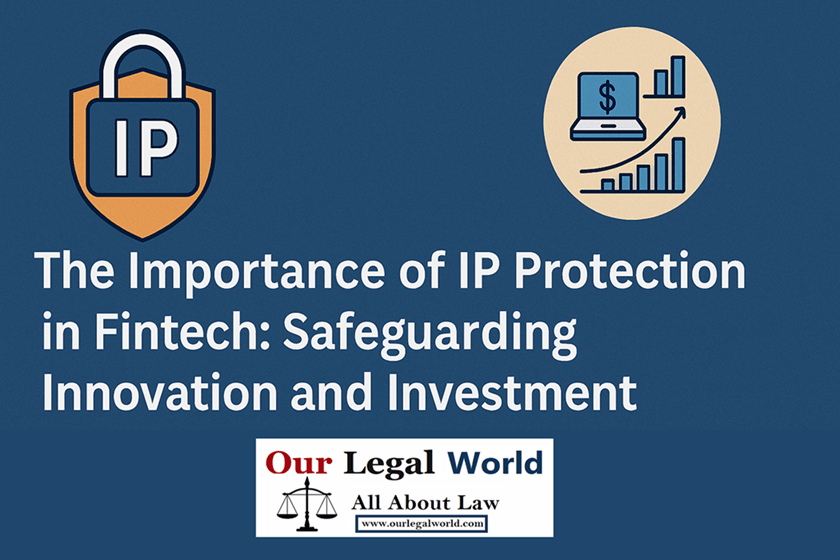IPR Defense against Mind Creation: IPR Club OurLegalWorld
Introduction
Intellectual property rights, as the name suggests, are the rights of the owners of tangible and intangible creations. These rights are granted to genuine ideas, i.e. ideas that have not been previously registered. This includes copyrights, patents, trademarks,[1] trade secrets, new geographical indications, registration of new plants/plant species, new industrial designs and other intellectual creations.
The approach to intellectual property has changed from a purely patent tool to one that covers everything the mind can concretize. Once a simple tool to reward inventors and authors, intellectual property is now the weapon of sophisticated litigants impersonating lawyers.
It is currently witnessed by the race of vaccine manufacturers to get patent of manufactured vaccines around the world. Intellectual property rights are granted to the intellectual activity of an individual or are rights with respect to an intangible creation of a person. These are exclusive rights to prevent research on the inventor or whoever owns the idea. Intellectual property law refers to a patent[2] granted for a particular product, process, machine, manufacture, and composition of matter, trademark[3] on drawings, symbols, three-dimensional features such as the shape and packaging of goods, sound features such as music or vocals. Sounds, smells or colors used as distinguishing marks, trade containers, industrial design, appearance design[4] and copyright[5]-oriented rights.
Also Read: Evergreening of Patents in Pharmaceutical Industry and Anti-trust Implications: IPR Club
What is IPR about?
Intellectual property is an intangible creation of the human mind, usually expressed or transformed into tangible form, to which specific ownership rights are assigned.
Examples of intellectual property include copyrights in books and articles, distinctive logo designs that represent soft drink companies and their products, unique design elements for websites, and patents on chewing gum manufacturing processes.
Intellectual property rights (IPR) can be defined as rights granted to people over the creation of their minds. They usually give authors exclusive rights to use their work for a certain period.
Intellectual property (IP) refers to creations of the mind: inventions, literary and artistic works, and symbols, names, images and designs used in commerce.
Intellectual property is an intangible creation of the human mind, usually expressed or transformed into tangible form, to which specific ownership rights are assigned. Examples of intellectual property include author copyrights for books and articles, designs for distinctive logos representing soft drink companies and their products, unique design elements for websites, and patents for chewing gum manufacturing processes.
Intellectual property rights (IPR) can be defined as rights granted to people through the creation of their minds. They usually give authors exclusive rights to use their work for a certain period.
Intellectual property (IP) refers to creations of the mind: inventions, literary and artistic works, and symbols, names, images and designs used in commerce.
International Conventions relating to IPR
Intellectual property rights are not limited to the national level, but extend to international levels as well. At the international level, there are many conventions regarding the protection of literary and artistic works. However, there are mainly two categories:
• Intellectual property laws relating to copyright.
• Intellectual property laws relating to industrial property.
There are two main conventions on intellectual property laws related to copyright
- Berne Convention, 1886
- Universal copyright convention of 1952, revised in 1971.
Intellectual property laws relating to industrial property: The Paris Convention[6], which was signed in Paris in March 1883. This convention is administered by WIPO[7]. This convention protects patents, utility models, industrial designs, trademarks, service marks, trade names, indications of source or origin, and the suppression of unfair competition.
The importance of IPR
The importance of intellectual property is manifested in maintaining the quality, safety and effectiveness of any product and service available in the market. These rights are granted to the inventor for the duration of the decision. Because the term of validity of each patent is 20 years from the filing date of the patent application, regardless of whether it is filed with a provisional or full specification. The patent date refers to the filing date of the patent application. The term of registration of each trademark is 10 years from the date of filing, which is considered the date of registration. In addition, copyrights usually last 60 years. Geographical indication registration is valid for 10 years. The registration period for a chip layout design is 10 years from the date of application for registration or 10 years from the date of first commercial use in India or an agreement country designated by the Government of India. . The protection period for registered varieties varies from crop to crop. This is 18 years for trees and vines and 15 years for other crops and established varieties
Conclusion
Intellectual property is a public right granted by the Government of India. The Law on Intellectual Property other producers of intellectual goods and services by granting certain temporary rights to control the use of intellectual goods and services. Rights are given to people in relation to the creation of the mind. They usually grant authors exclusive rights to use their work for a specified period. It is an exclusive right granted by the government to protect the novelty and originality of patent-oriented data and to maintain the quality, safety, efficacy, standards or certifications of medicines, products and services. Intellectual property rights are government rights granted by the Government of India. Intellectual property law deals with intellectual activities in the fields of industry, science, literature and art. These rights protect creators and other producers of intellectual goods and services by granting certain temporary rights to control their use. A right given to humans regarding the creation of the mind. They usually give authors exclusive rights to use their work for a period. It is an exclusive right granted by the state to protect the novelty and originality of data related to patents and to maintain the quality, safety, efficacy, standard or certification of medicines, products and services.
Written by Vani Sharma
[1] A trademark is a word, phrase, symbol, or design that helps distinguish the source of the goods of one party/organisation from that of others.
[2] Patent Act 1970: The object of the act is twofold first is protection of the individual interest of the patentee and second one is protection of the interest of the society.
[3] Trademark Act, 1999
[4] Design Act, 2000 The Act under section 2(d) gives a comprehensive definition of design.
[5] Copyright Act, 1957. Copyright is defined in section 14 of the copyright act.
[6] Paris Convention on Industrial Property of 1887. It was revised several times and amended in 1979.
[7] The World Intellectual Property Organization, or WIPO, is a specialized UN agency created in 1967 to promote the protection of intellectual property (IP) and encourage creative activity worldwide. WIPO is essentially a global forum for intellectual property policy, services, information and cooperation.









![Call for Paper of RMLNLU Law Review [Volume XVI (2025-26)]](https://www.ourlegalworld.com/wp-content/uploads/2025/07/ORIGINAL-CFP.png)
